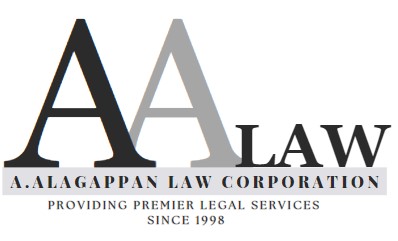
Bankruptcy
Who is a bankrupt?
1. A person may be
declared bankrupt by the High Court if he owes the creditor(s) more than
$10,000, which is payable immediately but he is unable to pay.
Bankruptcy Applications
2. There are two types of bankruptcy applications:-
(a) debtor’s bankruptcy application; and
(b) creditor’s bankruptcy application.
3. A debtor’s bankruptcy
application is when the debtor himself applies for bankruptcy.
4. A creditor’s
bankruptcy application is when the creditor/s apply to court to make a person a
bankrupt.
Procedure
Debtor’s Bankruptcy
Application
5. For a debtor’s
bankruptcy application, the debtor will have to file the following documents:-
(a) Originating Summons (Debtor’s
Bankruptcy Application);
(b) Supporting Affidavit
(Bankruptcy)
(c) Statement of Affairs;
(d) Affidavit verifying the Statement of
Affairs; and
(e) Supporting Affidavit
(Bankruptcy – Debt Repayment Scheme applies or does not apply, whichever
affidavit is applicable)
6. The Court will also consider the debtor’s eligibility for
the Debt Repayment Scheme (see paragraphs 16 to 25 below).
Creditor’s Bankruptcy Application
7. To commence a
creditor’s bankruptcy application, the creditor has to first issue a Statutory
Demand to demand payment from the debtor.
8. Once the Debtor is
served with the Statutory Demand, he has two options:-
(a) pay the debt within 21 days;
(b) apply to court to set aside the
Statutory Demand within 14 days.
Setting aside a Statutory
Demand and opposing a creditor’s bankruptcy application
9. If a debtor wishes
to set aside the Statutory Demand served on him, the debtor must file the
following documents:-
(a) Originating Summons (Bankruptcy – To
set aside Statutory Demand); and
(b) Supporting Affidavit.
10. In the Supporting
Affidavit, the debtor can:-
(a) state the reasons for not admitting
the debt’;
(b) admit the debt but state reasons why
the debt was not immediately payable;
(c) admit the debt and offer to secure or
compound it to the creditor’s satisfaction;
(d) inform the court
that the debt is a secured debt and provide details of the security and its
value;
(e) present a counterclaim or cross
demand;
(f) if the debt is a
judgment debt, prove that the execution on the judgment debt has been stayed;
(g) state reasons why
the statutory demand does not comply with the Bankruptcy Rules and/or
(h) state personal
grounds or other reasons why the statutory demand should be set aside.
11. During the hearing
the Court will decide whether the Statutory Demand should be set aide. If the Statutory Demand is set aside, the
proceedings end there. If the Statutory Demand is not set aside, the creditor
can proceed to file a Bankruptcy Application.
12. Once the Bankruptcy
Application is filed in Court, the Court will fix the matter for hearing. The
creditor should also file a Proof of Debt along with the Bankruptcy
Application.
13. At the hearing the
Court will first consider if the debtor is eligible for the Debt Repayment Scheme
(see paragraphs 16 to 25 below).
a) If payment is
still not made by the hearing date and the debtor is not eligible for the Debt
Repayment Scheme, the High Court may make a Bankruptcy Order and declare the debtor bankrupt.
b) If the debtor
is eligible for the Debt Repayment Scheme, the hearing will be adjourned for
about six (6) months for the Official Assignee to interview the debtor and
assess the suitability of the debtor for the Debt Repayment Scheme.
14. If a debtor has been
served with his creditor’s bankruptcy application, he can approach the
creditor’s solicitor to negotiate a settlement and persuade the creditor to
withdraw the creditor’s bankruptcy application.
15. Alternatively, if a
debtor wishes to oppose to a creditor’s bankruptcy application, he may do so by
filing a Notice of Objections. In his Notice of Objections, the debtor has to
state his reasons for objecting.
Debt Repayment Scheme (DRS)
16. Under the DRS, the debtor can enter into a Debt Repayment Plan (DRP) with the creditors which will allow a debtor to avoid bankruptcy.
17. The debtor will have
five (5) years to repay his debt. Thereafter if the debtor has paid his debt in
full, the Defendant will be discharged from bankruptcy.
18. The Official
Assignee will assess and determine the debtor’s eligibility and suitability for
the DRS. It is not possible to apply or sign up for the DRS.
19. To be eligible for
the DRS, the debtor has to meet the following criteria:-
(a) does not have debts
exceeding $100,000, or the aggregate of his unsecured debts in respect of which
the bankruptcy application was made does not exceed $100,000;
(b) the debtor is not an undischarged
bankrupt;
(c) the debtor was not
adjudged a bankrupt in the five (5) years preceding the date of the
application;
(d) the debtor is not presently subject to
a voluntary arrangement;
(e) the debtor has not
been subject to a voluntary arrangement in the five (5) years preceding the
date of the application;
(f) the debtor is not presently subject
to a debt repayment scheme
(g) the debtor has not
been subject to a debt repayment scheme in the five (5) years preceding the
date of the application;
(h) the debtor is not a sole proprietor;
(i) the debtor is not a partner in a
firm.
The DRS does
not apply to the debtor is he fails to satisfy any of the above
conditions. The debtor must also be
gainfully employed and earning a regular income;
20. The debtor will have
to submit the following documents for the OA to assess his suitability for the
DRS:-
(a)
Statement of Affairs;
(b)
Income and Expenditure Statement;
(c) Debt Repayment Plan; and
(d)
Supporting documents.
The debtor has
to complete the online submission and submit the documents online within 14
days, failure of which, the case will be referred to Court for the bankruptcy
proceedings to be heard again.
21. A meeting of the
creditors will be held at the OA’s office for further assessment of his suitability for the DRS and the debtor’s attendance is compulsory. The issues
discussed at the creditor’s meeting includes the debtor’s monthly instalment as
well as the terms and conditions of the DRP. If the debtor does not attend the
meeting without a valid reason, he will be deemed unsuitable for the DRS.
22. If a debtor is
assessed by the OA to be suitable for the DRS, the DRS administrator will
devise a DRP for the debtor. Once the debtor has made the first payment, the OA
will inform the debtor, the Court and the creditor of the outcome of the
assessment of the DRS and the commencement of the DRP. If a bankruptcy
application was made against the debtor, the application will be deemed as
withdrawn.
23. Once a debtor is
assessed to be suitable for the DRS, he will have to pay $300.00 being the first annual fee and the approved first monthly instalment.
24. If a creditor
disagrees with the DRP, he may file a Notice of Appeal within 14 days from the
date of notice of the OA’s decision on the approved DRP or Notice of
Commencement of DRP.
25. If the debtor fails
to comply with the terms of the DRP, the OA may issue a Certificate of Failure
and the debtor’s creditor may initiate fresh bankruptcy proceedings.
Consequences of bankruptcy
26. Once a person is made
a bankrupt, his assets will vest in the Official Assignee for the benefit of
the creditors.
27. Once the Bankruptcy
Order is made, the bankrupt is required to attend the OA’s office to be briefed
on his responsibilities as a bankrupt. The bankrupt is also required to submit
his Statement of Affairs to the OA within 21 days from the date of the
Bankruptcy Order. If the bankrupt fails to submit his Statement of Affairs
without reasonable excuse, or submits a Statement of Affairs which is false,
misleading or fails to disclose material information, be may be guilty of an
office punishable with a fine not exceeding $10,000.00 or be imprisoned to a
term not exceeding 2 years.
28. If the Bankrupt is employed,
he must make a monthly contribution which will be accumulated in the bankruptcy
estate. The amount of monthly contribution he has to make will be determined by
the OA after taking into account the Bankrupt’s reasonable expenses for him and
his family.
29. A bankrupt is not
allowed to travel overseas without the OA’s permission. If he attempts to
travel overseas without the OA’s permission, he may be stopped from leaving
Singapore and his passport may be detained by the Immigration and Checkpoints
Authority. It is an offence to travel
overseas without the OA’s permission and if found guilty, the bankrupt may be
liable to a fine not exceeding $10,000.00 or to imprisonment for a term not
exceeding 2 years or both.
30. If a bankrupt wants
to manage a business or corporation and/or act as a director or take part in
the management of any corporation, he needs to obtain permission from the High
Court or the OA. His application will be considered on its own merits; it may
be refused by the OA or be subject to certain conditions imposed by the OA. (section
131 of the Act)
31. A bankrupt will not
be able to commence or continue any lawsuits other than an action for damages
or compensation in respect of personal injuries. If he wishes to commence or
continue any court action other than those listed above, he will need the
consent of the OA (section 131). If the OA’s permission is not obtained, the
bankrupt may be guilty of an offence and be liable to a fine not exceeding
$10,000.00 or to imprisonment for a term not exceeding 2 years or both.
32. A bankrupt may be
able to obtain further credit. However if he wants to loan more than $500, he
must disclose his bankruptcy status to the lender.
Assets
33. Asset are anything
of value which belongs to the bankrupt at the date of the Bankruptcy Order. Any
gifts given to him before he is discharged from bankruptcy is also considered
as an asset.
34. A bankrupt will be
allowed to keep certain possessions which are necessary for his everyday life
and are not too extravagant.
35. Bankrupts will be
able to retain the following assets:-
(a) private property which he holds on
trust for another;
(b) his HDB flat(s) provided at least one
of the owners is a Singaporean;
(c) money in his CPF accounts
(d) his life insurance policies where the
beneficiaries are his spouse or children;
(e) any other property which is excluded
by law from the reach of his creditors; and
(f) compensation
awarded to him in legal action in relation to personal injuries or wrongful
acts done against him.
36. The bankrupt’s secured
creditors will have the right to sell the secured asset(s) or goods if he
defaults on your payments to them. If the proceeds of sale exceeds the value of
the secured debt, the OA will require that the remaining proceeds be remitted
to the bankruptcy estate for the benefit of his other creditors.
37. A bankrupt can open
a bank account; the OA will assist him with it. The bankrupt must pay his monthly
contributions towards the bankruptcy estate through this bank account via GIRO.
He must also furnish all information relating to the account as required by the
OA. The OA reserves the power to close the account.
Discharge from bankruptcy
38. One may be
discharged as a bankrupt through the following ways:-
(a) annulment of the
Bankruptcy Order by settling your debt(s) in full or through an Offer of Composition
or a Scheme of Arrangement;
(b) discharge by the High Court;
(c) discharge by Certificate of the
Official Assignee.
39. Upon discharge from
bankruptcy, the accumulated contributions will be distributed to the Bankrupt’s
creditors.
Caution to Debtors
40. If you receive
Letters of Demand from your creditors, Statutory Demands or Writs of Summons
from the court, do not ignore them. Seek legal advice if you do not understand
the contents. Even if you refuse to respond to your creditors or refuse to
accept service of their documents, you can still be made a bankrupt.
Sources: adopted from:
-
Ministry of Law website
-
Bankruptcy Act
-
Supreme Court website
-
Insolvency and Public Trustee Office
As at 21 April 2016

